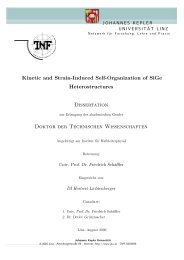Diplomarbeit Diplom-Ingenieur - Institut für Halbleiter
Diplomarbeit Diplom-Ingenieur - Institut für Halbleiter
Diplomarbeit Diplom-Ingenieur - Institut für Halbleiter
You also want an ePaper? Increase the reach of your titles
YUMPU automatically turns print PDFs into web optimized ePapers that Google loves.
10<br />
seen in Fig. 2.4, where also the structure of the HQ buffer is shown. Fig. 2.5 shows a<br />
TEM image of an annealed sample, where also the buffer structure can be seen.<br />
Essential for the growth of a high quality PbTe SQW is a high-quality CdTe buffer<br />
with low surface roughness and low lattice defects. The lattice constants of GaAs and<br />
CdTe differ by ~15% which lead to CdTe growth with a high dislocation density. To<br />
grow a high-quality CdTe buffer, fist a 100 nm thick low temperature (LT) CdTe film<br />
was grown at 280°C on a sulphur treated GaAs substrate, followed by 300 nm CdTe<br />
at 320°C providing a (100) oriented CdTe surface. This was capped with a 100 nm<br />
thick MnTe layer to suppress the re-evaporation during the following thermal<br />
annealing step at 380°C for 30min. On the CdTe/MnTe buffer a superlattice of twenty<br />
5 nm thick MnTe / 2 nm thick CdTe sublayers were grown at 280°C and then<br />
finalised with a CdTe layer (300nm-900nm) at 320°C [28]. Such high-quality buffers,<br />
or similar ones, were used for all samples investigated within this thesis. The root-<br />
mean-square roughness of such a HQ buffer is less than 0.5nm in an area of<br />
3μm × 3μm (measured by atomic force microscopy).<br />
Figure 2.5: A typical PbTe/CdTe heterostructure recorded with the TEM along the [110]<br />
zone axis. The layers with Mn content are brighter and clearly visible. The HQ buffer<br />
was finalised with 900nm CdTe. The image shows an annealed sample. The PbTe dots<br />
can be seen beneath the surface of the sample at the top of the image.<br />
On such high quality CdTe buffers the PbTe SQWs were grown at temperatures<br />
from 220°C to 280°C with different thickness. The CdTe (100) surface is polar,











